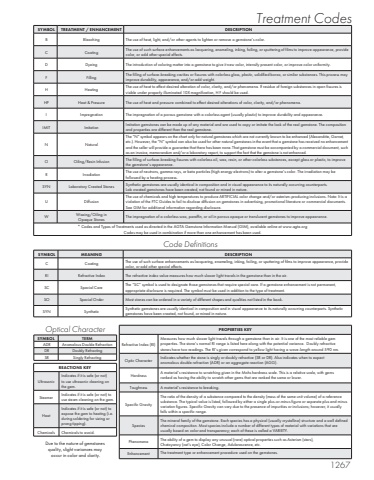Page 1277 - Demo
P. 1277
1267SYMBOL TREATMENT / ENHANCEMENT DESCRIPTIONB Bleaching The use of heat, light, and/or other agents to lighten or remove a gemstone%u2019s color.C Coating The use of such surface enhancements as lacquering, enameling, inking, foiling, or sputtering of films to improve appearance, provide color, or add other special effects.D Dyeing The introduction of coloring matter into a gemstone to give it new color, intensify present color, or improve color uniformity.F Filling The filling of surface-breaking cavities or fissures with colorless glass, plastic, solidified borax, or similar substances. This process may improve durability, appearance, and/or add weight.H Heating The use of heat to effect desired alteration of color, clarity, and/or phenomena. If residue of foreign substances in open fissures is visible under properly illuminated 10X magnification, H F should be used.HP Heat & Pressure The use of heat and pressure combined to effect desired alterations of color, clarity, and/or phenomena.I Impregnation The impregnation of a porous gemstone with a colorless agent (usually plastic) to improve durability and appearance.IMIT Imitation Imitation gemstones can be made up of any material and are used to copy or imitate the look of the real gemstone. The composition and properties are different than the real gemstone.N NaturalThe %u201cN%u201d symbol appears on the chart only for natural gemstones which are not currently known to be enhanced (Alexandrite, Garnet, etc.). However, the %u201cN%u201d symbol can also be used for other natural gemstones in the event that a gemstone has received no enhancement and the seller will provide a guarantee that there has been none. That gemstone must be accompanied by a commercial document, such as an invoice, memorandum and/or a laboratory report, to support the fact that the gemstone is not enhanced.O Oiling/Resin Infusion The filling of surface-breaking fissures with colorless oil, wax, resin, or other colorless substances, except glass or plastic, to improve the gemstone%u2019s appearance.R Irradiation The use of neutrons, gamma rays, or beta particles (high energy electrons) to alter a gemstone%u2019s color. The irradiation may be followed by a heating process.SYN Laboratory Created Stones Synthetic gemstones are usually identical in composition and in visual appearance to its naturally occurring counterparts. Lab created gemstones have been created, not found or mined in nature.U DiffusionThe use of chemicals and high temperatures to produce ARTIFICIAL color change and/or asterism-producing inclusions. Note: It is a violation of the FTC Guides to fail to disclose diffusion on gemstones in advertising, promotional literature or commercial documents. See GIM for additional information regarding disclosure.W Waxing/Oiling in Opaque Stones The impregnation of a colorless wax, paraffin, or oil in porous opaque or translucent gemstones to improve appearance.* Codes and Types of Treatments used as directed in the AGTA Gemstone Information Manual (GIM), available online at www.agta.orgCodes may be used in combination if more than one enhancement has been used.SYMBOL MEANING DESCRIPTIONC Coating The use of such surface enhancements as lacquering, enameling, inking, foiling, or sputtering of films to improve appearance, provide color, or add other special effects.RI Refractive Index The refractive index value measures how much slower light travels in the gemstone than in the air.SC Special Care The %u201cSC%u201d symbol is used to designate those gemstones that require special care. If a gemstone enhancement is not permanent, appropriate disclosure is required. The symbol must be used in addition to the type of treatment.SO Special Order Most stones can be ordered in a variety of different shapes and qualities not listed in the book.SYN Synthetic Synthetic gemstones are usually identical in composition and in visual appearance to its naturally occurring counterparts. Synthetic gemstones have been created, not found, or mined in nature.Code DefinitionsOptical CharacterSYMBOL TERMADR Anomalous Double RefractionDR Doubly RefractingSR Singly RefractingDue to the nature of gemstones quality, slight variances may occur in color and clarity.Treatment CodesPROPERTIES KEYRefractive Index (RI)Measures how much slower light travels through a gemstone than in air. It is one of the most reliable gem properties. The stone%u2019s normal RI range is listed here along with the potential variance. Doubly refractive stones have two readings. The RI%u2019s given correspond to yellow light having a wave-length around 590 nm.Optic Character Indicates whether the stone is singly or doubly refractive (SR or DR). Also indicates when to expect anomalous double refraction (ADR) or an aggregate reaction (AGG). Hardness A material%u2019s resistance to scratching given in the Mohs hardness scale. This is a relative scale, with gems ranked as having the ability to scratch other gems that are ranked the same or lower.Toughness A material%u2019s resistance to breaking. Specific GravityThe ratio of the density of a substance compared to the density (mass of the same unit volume) of a reference substance. The typical value is listed, followed by either a single plus-or-minus figure or separate plus and minus variation figures. Specific Gravity can vary due to the presence of impurities or inclusions; however, it usually falls within a specific range.SpeciesThe mineral family of the gemstone. Each species has a physical (usually crystalline) structure and a well defined chemical composition. Most species include a number of different types of material with variations that are usually based on color and transparency; each of these is called a VARIETY.Phenomena The ability of a gem to display any unusual (rare) optical properties such as Asterism (stars), Chatoyancy (cat%u2019s eye), Color Change, Adularescence, etc. Enhancement The treatment type or enhancement procedure used on the gemstones.REACTIONS KEYUltrasonicIndicates if it is safe (or not) to use ultrasonic cleaning on the gem.Steamer Indicates if it is safe (or not) to use steam cleaning on the gem.HeatIndicates if it is safe (or not) to expose the gem to heating (i.e. during soldering for sizing or prong tipping).Chemicals Chemicals to avoid.


